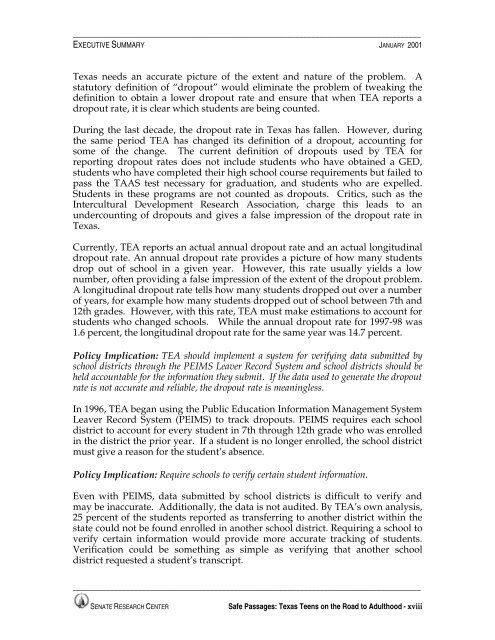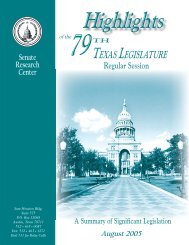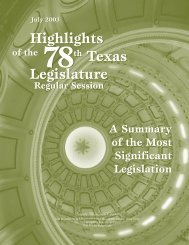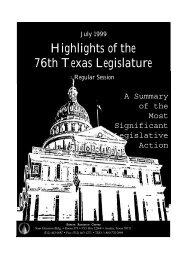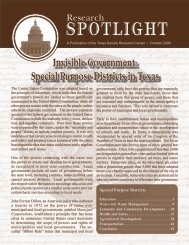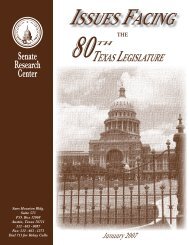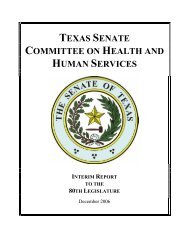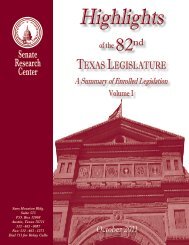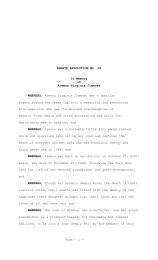Texas Teens Cover - Senate
Texas Teens Cover - Senate
Texas Teens Cover - Senate
You also want an ePaper? Increase the reach of your titles
YUMPU automatically turns print PDFs into web optimized ePapers that Google loves.
______________________________________________________________________________________<br />
EXECUTIVE SUMMARY JANUARY 2001<br />
<strong>Texas</strong> needs an accurate picture of the extent and nature of the problem. A<br />
statutory definition of “dropout” would eliminate the problem of tweaking the<br />
definition to obtain a lower dropout rate and ensure that when TEA reports a<br />
dropout rate, it is clear which students are being counted.<br />
During the last decade, the dropout rate in <strong>Texas</strong> has fallen. However, during<br />
the same period TEA has changed its definition of a dropout, accounting for<br />
some of the change. The current definition of dropouts used by TEA for<br />
reporting dropout rates does not include students who have obtained a GED,<br />
students who have completed their high school course requirements but failed to<br />
pass the TAAS test necessary for graduation, and students who are expelled.<br />
Students in these programs are not counted as dropouts. Critics, such as the<br />
Intercultural Development Research Association, charge this leads to an<br />
undercounting of dropouts and gives a false impression of the dropout rate in<br />
<strong>Texas</strong>.<br />
Currently, TEA reports an actual annual dropout rate and an actual longitudinal<br />
dropout rate. An annual dropout rate provides a picture of how many students<br />
drop out of school in a given year. However, this rate usually yields a low<br />
number, often providing a false impression of the extent of the dropout problem.<br />
A longitudinal dropout rate tells how many students dropped out over a number<br />
of years, for example how many students dropped out of school between 7th and<br />
12th grades. However, with this rate, TEA must make estimations to account for<br />
students who changed schools. While the annual dropout rate for 1997-98 was<br />
1.6 percent, the longitudinal dropout rate for the same year was 14.7 percent.<br />
Policy Implication: TEA should implement a system for verifying data submitted by<br />
school districts through the PEIMS Leaver Record System and school districts should be<br />
held accountable for the information they submit. If the data used to generate the dropout<br />
rate is not accurate and reliable, the dropout rate is meaningless.<br />
In 1996, TEA began using the Public Education Information Management System<br />
Leaver Record System (PEIMS) to track dropouts. PEIMS requires each school<br />
district to account for every student in 7th through 12th grade who was enrolled<br />
in the district the prior year. If a student is no longer enrolled, the school district<br />
must give a reason for the student’s absence.<br />
Policy Implication: Require schools to verify certain student information.<br />
Even with PEIMS, data submitted by school districts is difficult to verify and<br />
may be inaccurate. Additionally, the data is not audited. By TEA’s own analysis,<br />
25 percent of the students reported as transferring to another district within the<br />
state could not be found enrolled in another school district. Requiring a school to<br />
verify certain information would provide more accurate tracking of students.<br />
Verification could be something as simple as verifying that another school<br />
district requested a student’s transcript.<br />
______________________________________________________________________________________<br />
SENATE RESEARCH CENTER<br />
Safe Passages: <strong>Texas</strong> <strong>Teens</strong> on the Road to Adulthood - xviii


